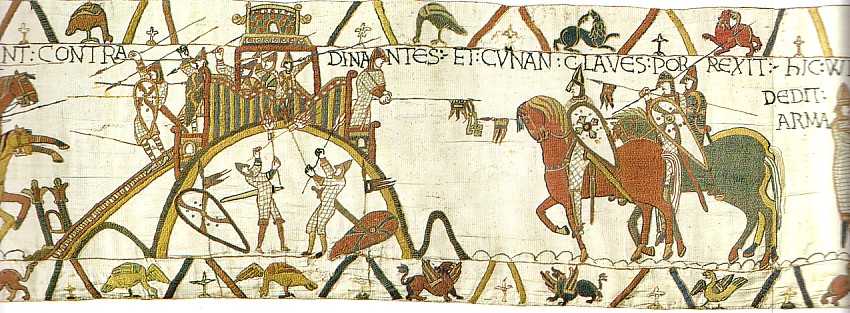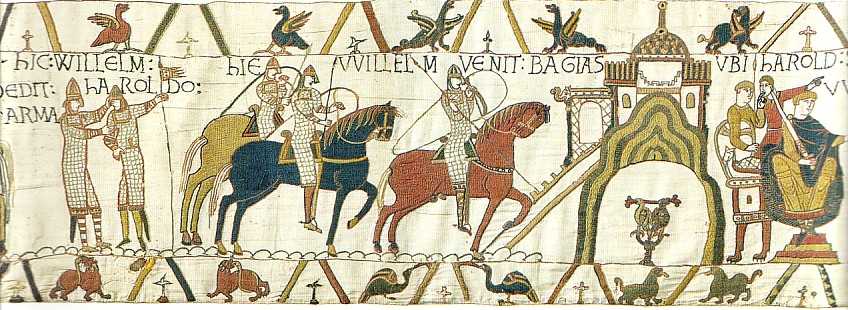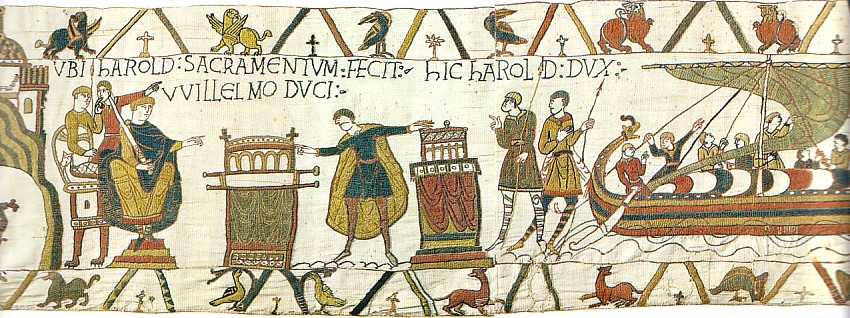
...THE MEN OF DINAN - AND CONAN HAS HELD OUT THE KEYS - HERE WILLIAM...
The use of lances as missiles, both on foot and from horseback, is clearly rendered in this scene: three "javelins" are airborne coming from the castle, and three from the horsemen in return. As their presence is impossible to explain, other than having been hurled, this is clear evidence of javelins in common use by both Normans and Bretons.
Holding out keys on the longest lance in the world would not reach down to the plain from the wall of a keep built on a motte: this scene is artistic licence: an established motte-and-bailey castle (as opposed to a quickly erected border fortress, or one like William's at Hastings) was upwards of thirty feet above the surrounding plain, and nearly twice that height above the surrounding ditch from which the motte was dug. The scene must represent a simplification of Conan holding out the keys on his lance from the bailey wall or gatehouse.
Curiously long-handled torches are employed to fire the wooden castle. I think these are both literal and figurative: long handles would easily allow a torch to be thrust under eaves to ignite a roof (see the burning of an English house later when William's army is harrying the Sussex countryside: those men are also using long-handled brands). Figuratively, long-handled torches here show that the fire-setting troops climbed the motte and fired the actual keep.
Again we see duke William associated with the Christian cross: this time ornately blazoned upon his shield. The artists (or rather those supervising them) are not missing a trick: William is being played up as the righteous son of the church, soon to be the pope's darling in a crusade against England and the foresworn usurper Harold Godwinson.
The multiplicity of ways the Tapestry depicts armor is interesting and frustrating: because it has led students and scholars into errors, assuming that there must be several common forms of mail armor. But these diamond (and square) pattern suits of armor are not scale or even full-length padded garments. Let's imagine how pressed for time the artists were: and the available pool of swift, skilled stitchers for such a huge project: stitching thousands of rings had to be time consuming: much easier and quicker was it for some to sew a straight line. It looks almost as good as rings. For these leading scenes most of the armor is depicted this easy way: later for Hastings rings predominate. Equally possible is the increased skill of the artisans: by the time they got to the battle of Hastings they were getting pretty swift with this embroidering of detailed armor.
..HAS GIVEN HAROLD ARMS - HERE WILLIAM HAS COME TO BAYEUX - WHERE HAROLD...
The pennon on Harold's spear proclaims him a knight. He had agreed to aid William in his rights in England. In William's mind he was looking forward to the crown: Harold could not have believed such a thing, and probably felt that he could put William by merely becoming his vassal for certain holdings of his own there. This master-vassal relationship was viewed in France as unbreakable. But in England a thegn or housecarle was obligated to serve as a warrior because he was of the noble caste first. Whether or not he possessed even a single acre of land made no difference. If the king or his earl summoned the freemen to war he went. If he held land in his own right he could take his holding "where he would." He could choose his own master, and later leave him and choose another. If he held his land from the king, church or an earl, he could renounce his claims at any time and go elsewhere, and nothing was viewed as wrong with that in England. If Harold had any knowledge of the differences of fealty in Normandy, this knighting of his should have sent off warning bells.
The rear of William's helmet has tassles reserved for commanders. His mail is ornately decorated along the lower border. Although both hauberks appear to have "squared" rings, this is most likely the transition of the artisans from square and diamond patterns to rings, as they increased in familiarity with their work on the Tapestry. Note Harold's sword scabbard extending below his mail, and the hilt showing through a slit in his armor. His sword belt is worn under his armor, very clearly depicted here.
The knight on the dark horse appears to be riding a gelding. Five or possibly six earlier examples of non-stallion mounts appear to be mares (almost exclusively ridden by Englishmen). Although stallions were prefered by the vast majority of milites, yet the poorer sort would settle upon any suitably trained mount that was affordable. The social stigma of riding a lesser beast is something they would have to put up with. And as is the nature of any skilled group, some knights would not excell at horsemanship and would find a more docile mount less of a burden. The choice of a gelding would then be deliberate.
The lead horseman is obviously William because the hem on his mail is the same pattern.
Superimposed on the motte of Bayeux castle are two back to back birds, holding a double-ended sceptre in their beaks, signifying the shared fealty of Harold and William, and the impending oath taking which will legally unite their two realms (which in William's mind, will include the kingdom of England in a united Anglo-Norman empire, with Harold as his righthand man).
...TOOK THE OATH TO DUKE WILLIAM - HERE DUKE HAROLD...
This is the most detailed - facially - of the figures depicting William in the Tapestry: and his seated figure is majestic and over-sized, similar to the scenes where a seated king Edward bulks larger than other mortals around him.
Note the pair of figures behind the duke's throne: is the one holding his fingers up to the other's lips to stop him from "spilling the beans?" The story that Harold was tricked into promising William support in his claim to the English throne was attested by Harold himself, according to later Norman accounts (even the Anglo-Saxon Chronicle - "C" - admits that "William from Normandy (was) king Edward's kinsman," thus implying that he had a recognized claim). What made it worse for him was the hidden relics under the draperies of the alters. Perhaps the English artisans alluded to this Norman sneakiness by hinting that the two obsrvers behind William knew what was going on.
By first becoming William's vassal, Harold bound himself to support his lord in all his legal rights. Then came the oaths, sworn upon the host - under Harold's left hand - and also upon (hidden) holy relics, to help William forward his claim upon the English crown. The pact was to be sealed by marriages: Harold to one of William's daughters, and his sister to one of William's nobles.
Once these oaths had been made, Harold was free to return home.




